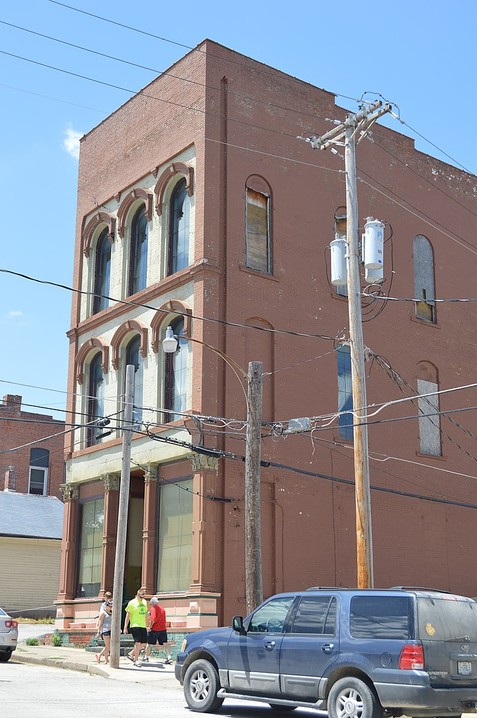Hock Building
Introduction
Text-to-speech Audio
This historic Hannibal structure was completed in 1872 by Ireland native John Hock shortly before his passing. Hock came to Hannibal around 1860, a little more than forty years after the city's founding in 1819. Hock managed the Hannibal Gas Company, founded by a group of St. Louis businessmen in 1858. Mounting debt during the early years of the Civil War forced the group to sell the nascent business at auction. Hock purchased the company outright in 1864. and completed this building eight years later during a time when Hannibal began to experience robust commercial and financial expansion.
Images
Hock Building

Backstory and Context
Text-to-speech Audio
Although Hannibal was founded about 1819, it did not see much growth, albeit conservative, until officials re-platted the city in 1836. Roughly thirty people called Hannibal home in 1836, but the population exceeded 450 by 1840. Initially, the city's business center existed in an area known today as what Mark Twain Historic District, named for the pen name of the famous author Sam Cleraens, who lived in the area. Because Hannibal is surrounded by hills, the city remained nearly isolated until modern road building allowed for better access into the town. In 1852, the Hannibal and New London Plank Road and Bridge Company organized; they constructed an access road that ostensibly opened Hannibal to outside locations by the 1860s. The new road also caused a shift in the business center which can be seen with the construction of this building and others.
The construction of the Hannibal & St. Joseph Railroad during the 1850s coincided with the town's economic transformation, transitioning from a city that exported agricultural commodities to one recognized as a lumber center. The expanding lumber industry led to financial growth for the small city, demonstrated by the increased number of banks in downtown Hannibal. Moreover, the economic expansion allowed the town to mature, as seen by the development of its utility companies and infrastructure, including the gas company Hack came to manage.
The Hock Building survives as one of the few early commercial buildings in Hannibal for which the builder is known: J. M. Fatten (1837-1898). In addition to building the Hock Building, Fatten profited from the city's burgeoning lumber industry by operating a local planing mill. When the building opened, O'Hern and Hayward, Plumbers, Gas & Steam Fitters occupied the first floor of the building; they primarily served gas customers. O'Hern, another Irish immigrant, married Hock's daughter, Mary. Meanwhile, the third floor functioned as a public meeting hall where a variety of organizations met, including the Negro Masonic Temple- a fraternal organization composed of many of the city's African American leaders.
Sources
"Hannibal Missouri History." Marion County MOGenWeb. genealogyvillage.com. Accessed October 29, 2022. https://momarion.genealogyvillage.com/history/hannhist.html.
Hamilton, Eslev. "Hannibal Central Business District Multiple Resource Nonination." National Register of Historic Places. mostateparks.com. 1985. https://mostateparks.com/sites/mostateparks/files/Broadway%20District.pdf.
Marschka, Lindsey. "Hannibal, MO: 'America's Hometown' Amidst Fictional Landscape." University of Missouri: Artifacts Journal. October 29, 2022. https://artifactsjournal.missouri.edu/2015/01/hannibal-mo-americas-hometown-amidst-fictional-landscape/
By Nyttend - Own work, Public Domain, https://commons.wikimedia.org/w/index.php?curid=34530294
